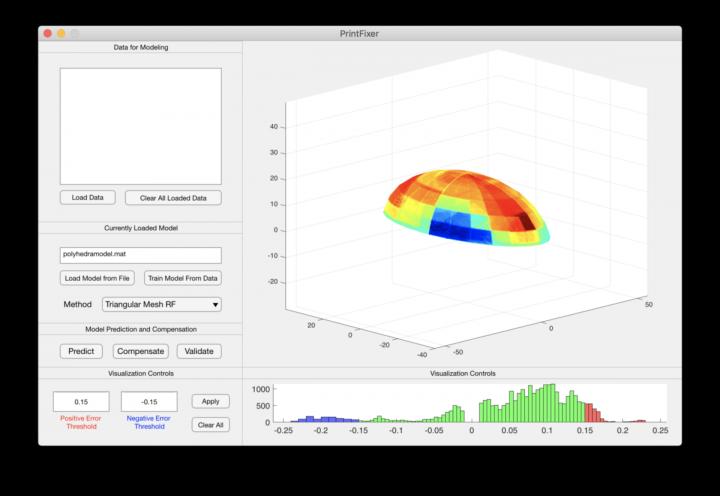Manufacturers, medical device companies and the general public will soon have access to powerful AI-driven 3-D printing software, the result of six years of research

Credit: Nathan Decker
3-D printing is often touted as the future of manufacturing. It allows us to directly build objects from computer-generated designs, meaning industry can manufacture customized products in-house, without outsourcing parts. But 3-D printing has a high degree of error, such as shape distortion. Each printer is different, and the printed material can shrink and expand in unexpected ways. Manufacturers often need to try many iterations of a print before they get it right.
What happens to the unusable print jobs? They must be discarded, presenting a significant environmental and financial cost to industry.
A team of researchers from USC Viterbi School of Engineering is tackling this problem, with a new set of machine learning algorithms and a software tool called PrintFixer, to improve 3-D printing accuracy by 50 percent or more, making the process vastly more economical and sustainable.
The work, recently published in IEEE Transactions on Automation Science and Engineering, describes a process called “convolution modeling of 3-D printing.” It’s among a series of 15 journal articles from the research team covering machine learning for 3-D printing.
The team, led by Qiang Huang, associate professor of industrial and systems engineering, chemical engineering and materials science, along with Ph.D. students Yuanxiang Wang, Nathan Decker, Mingdong Lyu, Weizhi Lin and Christopher Henson has so far received $1.4M funding support, including a recent $350,000 NSF grant. Their objective is to develop an AI model that accurately predicts shape deviations for all types of 3-D printing and make 3-D printing smarter.
“What we have demonstrated so far is that in printed examples the accuracy can improve around 50 percent or more,” Huang said. “In cases where we are producing a 3-D object similar to the training cases, overall accuracy improvement can be as high as 90 percent.”
“It can actually take industry eight iterative builds to get one part correct, for various reasons,” Huang said, “and this is for metal, so it’s very expensive.”
Every 3-D printed object results in some slight deviation from the design, whether this is due to printed material expanding or contracting when printed, or due to the way the printer behaves.
PrintFixer uses data gleaned from past 3-D printing jobs to train its AI to predict where the shape distortion will happen, in order to fix print errors before they occur.
Huang said that the research team had aimed to create a model that produced accurate results using the minimum amount of 3-D printing source data.
“From just five to eight selected objects, we can learn a lot of useful information,” Huang said. “We can leverage small amounts of data to make predictions for a wide range of objects.”
The team has trained the model to work with the same accuracy across a variety of applications and materials – from metals for aerospace manufacturing, to thermal plastics for commercial use. The researchers are also working with a dental clinic in Australia on the 3-D printing of dental models.
“So just like a when a human learns to play baseball, you’ll learn softball or some other related sport much quicker,” said Decker, who leads the software development effort development in Huang’s group. “In that same way, our AI can learn much faster when it has seen it a few times.”
“So you can look at it,” said Decker, “and see where there are going to be areas that are greater than your tolerances, and whether you want to print it.”
He said that users could opt to print with a different, higher-quality printer and use the software to predict whether that would provide a better result.
“But if you don’t want to change the printer, we also have incorporated functionality into the software package allowing the user to compensate for the errors and change the object’s shape – to take the parts that are too small and increase their size, while decreasing the parts that are too big,” Decker said. “And then, when they print, they should print with the correct size the first time.”
The team’s objective is for the software tool to be available to everyone, from large scale commercial manufacturers to 3-D printing hobbyists. Users from around the world will also be able to contribute to improving the software AI through sharing of print output data in a database.
“Say I’m working with a MakerBot 3-D printer using PLA (a bioplastic used in 3-D Printing), I can put that in the database, and somebody using the same model and material could take my data and learn from it,” Decker said.
“Once we get a lot of people around the world using this, all of a sudden, you have a really incredible opportunity to leverage a lot of data, and that could be a really powerful thing,” he said.
###
Media Contact
Amy Blumenthal
[email protected]
917-710-1897
Original Source
https:/
Related Journal Article
http://dx.




